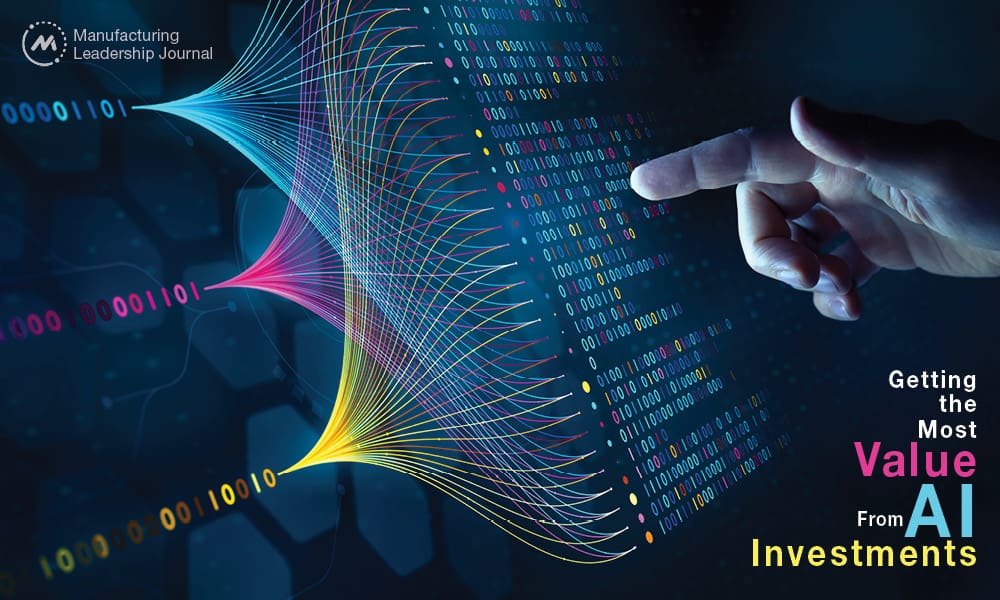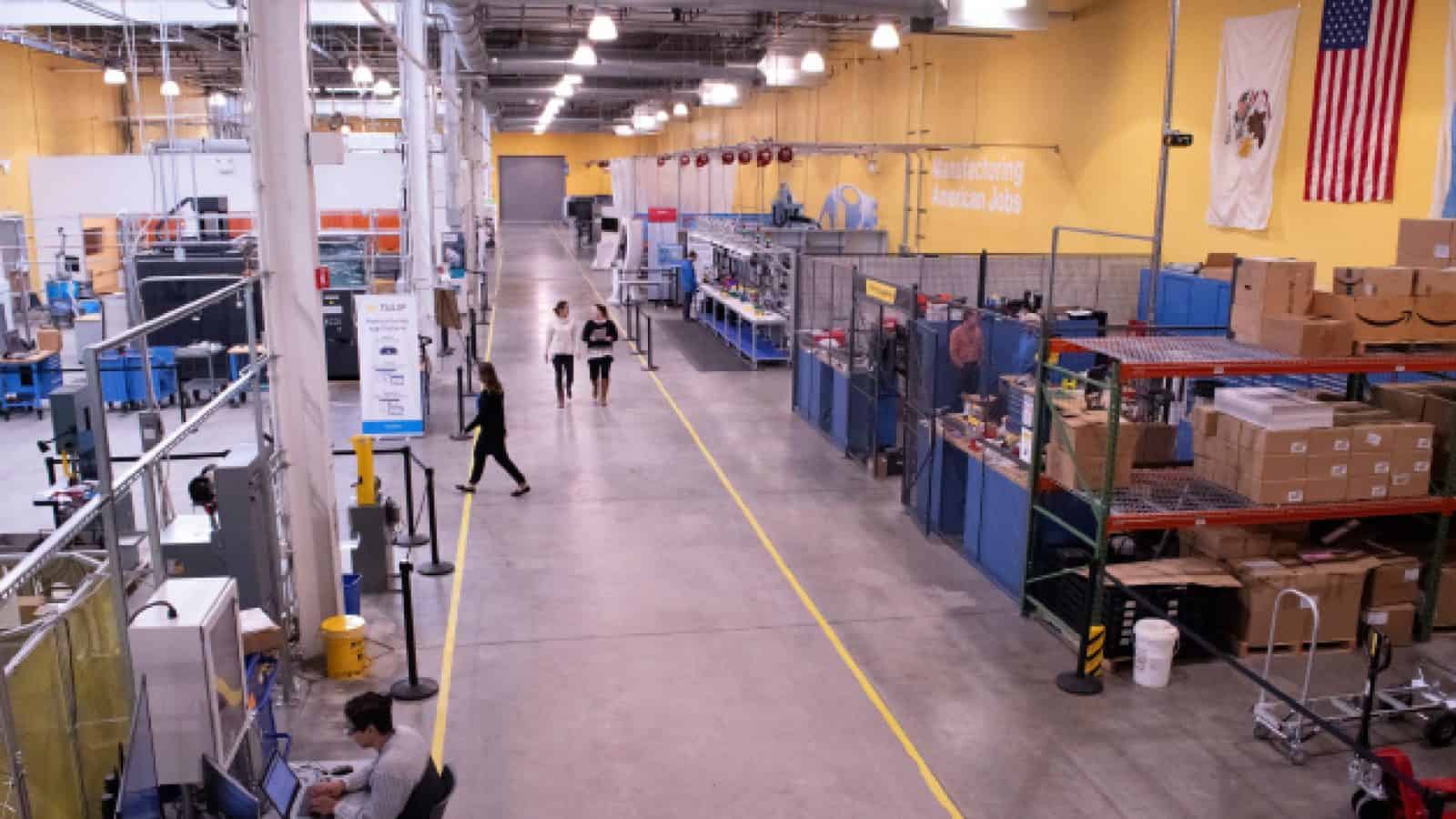Getting the Most Value from AI Investments

To capitalize on AI, manufacturers must learn how to prepare and analyze their data.

TAKEAWAYS:
● Manufacturers need to develop a thorough understanding of their data and the proper protocols for using that data.
● Manufacturers can use advanced technologies like AI to become more nimble, deliver better operational insights, and gain a more nuanced understanding of customer needs and relationships.
● To take full advantage of their data, manufacturers need to focus on data and system architecture, data governance, and data analytics.
The manufacturing sector historically has been a slow adopter when it comes to investments in artificial intelligence (AI) and other transformative technologies that require a solid foundation of data and clear practices around data use. It’s common for organizations to have vast amounts of data but lack insight from that data for several reasons, including the persistence of manual data collection, information existing in silos, and failure to segment customers in meaningful ways.
There has been significant hype around generative AI in 2023, but feeding the appropriate data into such AI tools is critical if companies want to benefit from the technology. Manufacturers looking to exploit advanced technologies to their fullest extent need to develop a thorough understanding of what data they have and proper protocols for using that data. Companies must capture, curate, and cleanse the data they have before they can determine how best to monetize them.
By first preparing the data properly, teams will then be able to use data not just for day-to-day operational tasks or metrics—such as how much product shipped on a given day or how inventory levels have changed in recent months—but to think more creatively about what else they can learn from data sets.

“Manufacturers that foster curiosity among their leadership and employees about AI will better position themselves to creating a factory of the future.”
Manufacturers that foster curiosity among their leadership and employees will better position themselves to create a factory of the future. Being a leader in AI will be necessary to remain competitive. According to a June 2023 Manufacturing Leadership Council survey about AI in 2030, “while many manufacturers may only just be starting to leverage the possibilities of AI, they also have clear plans to accelerate that adoption significantly in the years ahead, with AI investment levels expected to rise in a substantial 96% of all the companies responding to the survey.”
Think Bigger: Developing a Research Agenda
The use of AI in a manufacturing setting goes well beyond the shop floor. Companies can harness AI to improve quote-to-cash and order-to-cash processes, identify revenue leakage in business models, and assess whether the business has effective contract procedures in place, for instance. Many of these applications come down to figuring out where the business lacks key processes, or where processes aren’t being followed.
For companies setting out to explore how AI can improve their business—whether via process mining, robotic process automation, or machine learning—developing a research agenda can help. That agenda should examine these key elements:
- Data outputs: Does the organization fully understand the key outputs/outcomes it is measuring? Are there other outputs that would be useful to capture?
- Correlations: How do various outcomes compare to each other, and are there indications that they may have a significant relationship?
- Explanatory variables: Which relationships between data outputs might be especially useful or informative going forward?
- Dimensions of analysis: What are the various ways teams can analyze data points to understand customer behaviors better? Are there seasonal or geographic implications?
Using internal and external data to support this research agenda can help companies identify new opportunities and reduce the amount of uncertainty they face in both the short term and long term.
Becoming a nimbler organization and delivering better operational insights to leadership are two important ripple effects of honing this agenda and reducing uncertainty. Perhaps even more critical is the ability to gain a more precise understanding of customer needs and relationships. Manufacturers can use AI to ferret out relationship patterns, meaningfully segment customers, and determine costs associated with various relationships. These insights can ultimately enable companies to develop more tailored approaches to their customers, partners, and vendors.

“Manufacturers can use AI to ferret out relationship patterns, meaningfully segment customers, and determine costs associated with various relationships.”
Optimizing supply chains, improving quality control, and making the shift from reactive maintenance to proactive, predictive maintenance are specific areas where manufacturers stand to benefit most from AI. Predictive maintenance, for instance, uses AI algorithms to analyze real-time data from sensors and other equipment to anticipate equipment maintenance needs and failures. By continuously monitoring data from the factory floor and comparing that data against key performance indicators, AI can detect anomalies or early signs of equipment malfunction. This allows for proactive measures to avoid costly, unplanned downtime and improve the life span of the equipment.[1]
Performing maintenance prior to failure leads to cost savings and minimizes costly repairs or replacements. By leveraging data analysis, pattern recognition, and predictive modeling capabilities, industrial organizations can optimize equipment performance, increase operational efficiency, reduce costs, and enhance overall productivity.[2]
Improving Your Data: Where to Start?
Manufacturers don’t always know where to begin to improve their ability to harness, filter, and analyze data. Connectivity among machines, products, employees, suppliers, customers, and processes across the value chain is critical to gaining actionable insights, but enabling that connectivity with Industry 4.0 technologies must be intentional.
To be able to take full advantage of the enormous amount of data they generate and collect, manufacturers need to focus on three foundational areas:
- Data and system architecture: Understand how to balance traditional system architecture with newer architecture such as cloud-based storage and Internet of Things devices.
- Data governance: Implement clear standards around the collection and use of information.
- Data analytics: Harness advanced analytics to go beyond pattern identification and develop truly predictive capabilities.
Manufacturers also need to make sure that teams throughout the organization have the same baseline level of data literacy, and provide training as needed to align that literacy. Data literacy makes it easier for teams to adhere to the same data processes, policies, and standards around information protection and security.

“Once manufacturers have created a solid data foundation and fostered a sense of curiosity among employees, they can determine how AI tools may benefit their business in the future.”
Ensuring that employees have a common understanding of data inputs, outputs, and applications will become increasingly important as members of the aging workforce retire, taking their institutional knowledge with them. Getting teams across the organization well-versed in how to identify and solve problems with data will be an enormous asset as experienced workers leave.
Looking to the Future
Once manufacturers have created a solid data foundation and fostered a sense of curiosity among employees, they can determine how AI tools may benefit their business in the future. They would need to consider the following:
- People: Identify worker-led tasks that generative AI could enhance, ultimately driving greater productivity.
- Revenue streams: Technological tools can help identify potential new sources of revenue.
- Data strategy: Collecting more proprietary data throughout operations can improve the company’s competitive advantage.
- Integration: Formalize best practices for merging generative AI with current workflows.
It would be irresponsible to implement AI in any function of the business, however, without addressing risks and challenges associated with the technology. These include ethical issues, job displacement, and data security and reliability. Any manufacturer looking to capitalize on the transformative power of AI needs to have a clear understanding and assessment of these risks if they want to reap any benefits. M
About the authors:

George Casey is a principal at RSM US LLP.

Matt Dollard is a principal and an industrials senior analyst at RSM US LLP.
[1] The content in this paragraph was originally published in an RSM article titled “The potential for artificial intelligence to transform manufacturing.”
[2] The content in this paragraph was originally published in an RSM article titled “The potential for artificial intelligence to transform manufacturing.”
